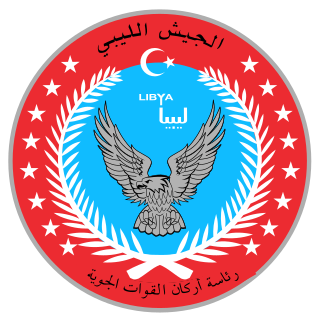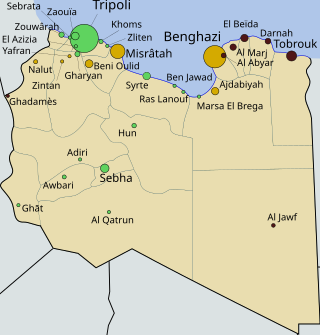
The Libyan Navy is the naval warfare branch of the Libyan Armed Forces. Established in November 1962, Libyan Navy has been headed by Admiral Mansour Bader, Chief of Staff of the Libyan Naval Force. Before the First Libyan Civil War it was a fairly typical small navy with a few missile frigates, corvettes and patrol boats to defend the coastline, but with a very limited self-defence capability.
Zawiya, officially Zawia, is a city in northwestern Libya, situated on the Libyan coastline of the Mediterranean Sea about 47 km (29 mi) west of Tripoli, in the historic region of Tripolitania. Zawiya is the capital of the Zawiya District.

The Libyan Air Force is the branch of the Libyan Armed Forces responsible for aerial warfare. In 2010, before the Libyan Civil War, the Libyan Air Force personnel strength was estimated at 18,000, with an inventory of 374 combat-capable aircraft operating from 13 military airbases in Libya. Since the 2011 civil war and the ongoing conflict, multiple factions fighting in Libya are in possession of military aircraft. As of 2019 the Libyan Air Force is nominally under the control of the internationally recognised Government of National Accord in Tripoli, though the rival Libyan National Army of Marshal Khalifa Haftar also has a significant air force. In 2021, the air force is under command of the new President of Libya, Mohamed al-Menfi that replaced Fayez al-Sarraj.

The Libyan Army was the branch of the Armed Forces of the Libyan Arab Jamahiriya, the Libyan Arab Republic and the Kingdom of Libya responsible for ground warfare.

The Tripoli protests and clashes were a series of confrontations between Libyan anti-government demonstrators and forces loyal to Libyan leader Muammar Gaddafi in the capital city of Tripoli that took place in February 2011, at the beginning of the Libyan civil war. During the early days of the uprising, there was significant unrest in the city, but the city remained under the control of the government.

The Libyan Civil War began on 17 February 2011 as a civil protest and later evolved into a widespread uprising. By mid-August, anti-Gaddafi forces effectively supported by a NATO-led international coalition were ascendant in Tripolitania, breaking out of the restive Nafusa Mountains in the south to mount an offensive toward the coast and advancing from Misrata on loyalist-held cities and villages from the north and east.

The anti-Gaddafi forces, also known as the Libyan opposition or Libyan rebels, were Libyan groups that opposed and militarily defeated the government of Muammar Gaddafi during the First Libyan Civil War in 2011, killing him in the process. The Anti-Gaddafi forces were represented by the National Transitional Council and their National Liberation Army, which claimed to be the "only legitimate body representing the people of Libya and the Libyan state". These opposition forces included organized and armed militia groups, participants in the Libyan Civil War, Libyan diplomats who switched their allegiance from the Gaddafi-led government, and Libyan military units that switched sides to support the protesters.

The National Liberation Army, officially the National Liberation Armed Forces of the Free Libyan Republic, formerly known as the Free Libyan Army, was a Libyan military organisation affiliated with the National Transitional Council, which was constituted during the First Libyan Civil War by defected military members and civilian volunteers, in order to engage in battle against both remaining members of the Libyan Armed Forces and paramilitia loyal to the rule of Muammar Gaddafi. Its self proclaimed chief commander was General Khalifa Haftar, although the National Transitional Council preferred to appoint Major General Abdul Fatah Younes Al-Obeidi as its commander-in-chief. It had prepared for some time in portions of Eastern Libya controlled by the anti-Gaddafi forces for eventual full-on combat in Western Libya against pro-Gaddafi militants, training many men before beginning to go on the offensive. They have battled for control of Benghazi, Misrata, Brega, Ajdabiya, Zawiya and Ra's Lanuf as well as several towns in the Nafusa Mountains. They finally began the Battle for Tripoli in August 2011 when they attacked from the west of the city, as well as fomenting an internal uprising on 20 August.
The Battle of Gharyan took place during the Libyan Civil War between rebel anti-Gaddafi forces and forces loyal to Muammar Gaddafi for control of the Tripolitanian city of Gharyan located at the eastern edge of the Nafusa Mountains.
The Zawiya skirmish began on 11 June 2011, when the National Liberation Army launched an attack into the coastal city of Zawiya, Libya in an attempt to recapture it from army units and militiamen loyal to Muammar Gaddafi. The attack was quickly crushed by the numerically superior and better-equipped loyalist forces, who had taken the city earlier in the Libyan Civil War after defeating rebel forces in a major battle that lasted from February to March 2011.
The Second Battle of Zawiya or Zawia took place during the Libyan Civil War between rebel anti-Gaddafi forces and forces loyal to Muammar Gaddafi for control of the Tripolitanian city of Zawia.
Mahdi al-Arabi, is a Libyan brigadier-general who served under the Libyan Armed Forces loyal to Muammar Gaddafi. He was the deputy chief of staff of the Libyan army. During the 2011 Libyan civil war he was put in charge of helping to suppress protests, most notably in the Libyan city of Zawiya.

The Libyan Civil War began on 15 February 2011 as a chain of civil protests and later evolved into a widespread uprising against the regime of Muammar Gaddafi. On 25 February, most of eastern Libya was reported to be under the control of protesters and rebel forces. Gaddafi remained in control of the cities of Tripoli, Sirte and Sabha. By 15 March, however, Gaddafi's forces had retaken more than half a dozen lost cities. Except for most of Cyrenaica and a few Tripolitania cities the majority of cities had returned to Gaddafi government control.

The timeline of the Libyan civil war begins on 15 February 2011 and ends on 20 October 2011. The conflict began with a series of peaceful protests, similar to others of the Arab Spring, later becoming a full-scale civil war between the forces loyal to Muammar Gaddafi's government and the anti-Gaddafi forces. The conflict can roughly be divided into two periods before and after external military intervention authorized by United Nations Security Council Resolution 1973.
The First Battle of Zawiya or Zawia was a battle during the Libyan Civil War between army units and militiamen loyal to Muammar Gaddafi and anti-Gaddafi forces for control of the city of Zawia.
The 2011 Libyan rebel coastal offensive was a major rebel offensive of the Libyan Civil War. It was mounted by anti-Gaddafi forces with the intention of cutting off the supply route from Tunisia for pro-Gaddafi loyalist forces in Tripoli.
The Zliten uprising was a local uprising in the Libyan Civil War, started by rebel anti-Gaddafi forces against loyalist pro-Gaddafi forces in the city of Zliten. The city was of strategic importance due to its close proximity to the capital of Tripoli. After Zliten, only two cities – Khoms and Tajura – separated the rebel stronghold of Misrata from Tripoli.

The Libyan Civil War began on 15 February 2011 as a civil protest and later evolved into a widespread uprising. However, by 19 March, Libyan forces under Colonel Muammar Gaddafi were on the brink of a decisive victory over rebels in Libya's east. That day, leading NATO members acted on United Nations Security Council Resolution 1973 which authorized member states "to take all necessary measures... to protect civilians and civilian populated areas under threat of attack in the Libyan Arab Jamahiriya, including Benghazi, while excluding an occupation force".

The 2011 Libyan Civil War began on 17 February 2011 as a civil protest and later evolved into a widespread uprising. After a military intervention led by France, the United Kingdom, and the United States on 19 March turned the tide of the conflict at the Second Battle of Benghazi, anti-Gaddafi forces regrouped and established control over Misrata and most of the Nafusa Mountains in Tripolitania and much of the eastern region of Cyrenaica. In mid-May, they finally broke an extended siege of Misrata.
The following lists events that happened during 2011 in Libya.






